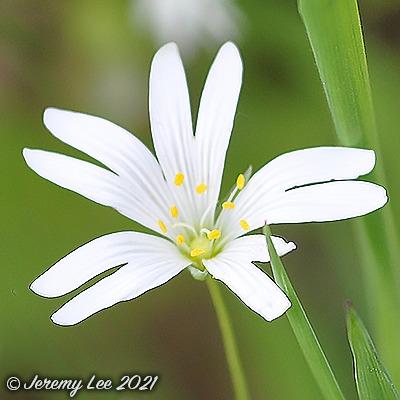
 |
|
Scientific Classifications explained » Amphibians » Ants » Aphids » Bees » Beetles » Birds » Bugs » Butterflies » Caterpillars » Damselflies » Dragonflies » Earwigs » Flies » Frog/Leafhoppers » Fungi » Galls » Grasshoppers » Harvestmen » Hoverflies » Lacewings » Ladybirds » Leaf Mines » Lichens » Mammals » Millipedes » Mosses » Moths » Sawflies » Slugs » Snails » Spiders » Trees & Shrubs » Wasps » Wild Flowers » Woodlice » Postboxes |
UK Nature > Wild Flowers > White Wild Flowers > Stellaria holostea

Scientific Name: Stellaria holostea Common Name: Greater Stitchwort Stellaria holostea, more commonly known as Greater Stitchwort, is a member of the carnation family and has white flowers that can reach up to 50cm in height. The leaves are green, thin, stalkless and grass-like. The flowers have five white petals, each of which is split half-way. This often gives Greater Stitchwort the appearance of having 10 petals. The flowers are usually 2–3cm in diameter and have an explosive seed-dispersal mechanism. In late spring, when the seed capsules ripen, they can be heard popping as they noisily fire their seeds. Not to be confused with Lesser Stitchwort (Stellaria graminea), its much smaller relative. Lesser Stitchwort’s flowers are just 0.5–1cm in diameter. Greater Stitchwort can be found across the UK, with swathes of these flowers appearing along roadside verges, in deciduous woodland and in hedgerows during spring. It is beneficial to many pollinating insects, including bees and butterflies, which are in search of nectar during the spring, and is also the food plant of several moths, including the Large Yellow Underwing (Noctua pronuba). |
|

https://www.uknature.co.uk is a website dedicated to showing the immense diversity of UK nature and wildlife. Our vast range of habitats, from lowland arable to snow covered mountains, from storm-ravaged coastlines to peaceful inland freshwater lakes and rivers, from dry, sandy heaths to deciduous and coniferous forests, all these habitats contribute to the abundance of UK nature. We have wild birds in huge numbers either residing or visiting our shores (597 recorded species as at July 2013) and we must also not forget the humble back garden with its grass lawns, flower beds filled with nectar rich flowers, shrubs and trees, all designed to attract huge numbers of insects such as bees, moths, butterflies and hoverflies; and finally the small ponds which provide safe havens for frogs, toads, newts and even slow worms and grass snakes. www.uknature.co.uk is the showcase for my personal passion, photographing uknature in all its glory. I sincerely hope you all enjoy the fruits of my labours. This site and all images contained therein is © Jeremy Lee 2004 - 2025. All Rights Reserved. Site design by Jeremy Lee. Site development & IT Support by Stuart Lee. |